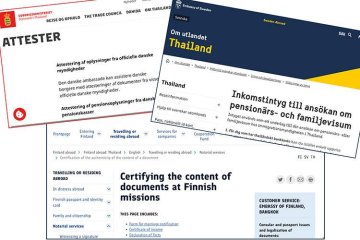The average number of daily road deaths during Songkran's "7 Dangerous Days" is 50 – based on government data for the last 10 years. The number of people who die on the roads in Thailand on an average day is somewhere between 39 and 66, depending on if you believe the government or the World Health Organization (WHO). So why the biannual hype?
Songkran is upon us again. This is the Thai New Year which, together with the regular New Year, is the time for mass exodus back to the homestead for most Thais.
Twice a year we are being fed daily news reports about the horrors of the traffic these 14 days. Play-by-play reporting from investigative journalist all over the country detail the various crashes. But what is the basis of this Media Gone Wild phenomenon? The basis seems to be that there are dangers lurking behind every curve these days, so better be careful.

BBC reporting
It is not only the Thai media reporting on this phenomenon, Western media does the same. BBC had a report in January about the horrors of last New Year in Thailand, where 489 people died during one week. The report also mentions the number 24,000 as the number of deaths yearly. If the BBC had divide the two numbers by 7 and 365, respectively, they would have discovered that 70 daily deaths during New Year wasn't much different from the 66 deaths on average.
What is the real number?
As mentioned, the average number of road deaths here is likely somewhere between 39 and 66 per day. These numbers stem from 2012, which is the year WHO used for their 2015 report covering 180 countries. The Thai government's own numbers said that 14,059 people died on the roads that year. WHO estimates that the real number is 24,237. The reason WHO don't use government statistics is that the numbers are often underreported.
But would the numbers not be underreported also during Songkran? Meaning that we could compare the average of 50 deaths with the government number 39, and conclude that indeed there was a significant increase in deaths? Not necessarily. All the attention during the two major holidays would possibly take care of much of the underreporting. Whoever is in charge of collecting the data during these days will certainly make sure to be as thorough as possible.
More people on the road
But even if one were to accept that the average number of road deaths were 39, an increase to 50 during these holidays should be nothing out of the ordinary. There are more people on the roads – at least towards the beginning and end of the period – but the speed is hampered by slow traffic. All in all, perhaps a toss-up.
But isn't the focus on road safety good? Does it not help to reduce the casualties? The answer is that it's uncertain. A statistician would look at the data and perhaps conclude "random variations". But one thing is sure – all the hype and regulations makes it more of a hassle to drive during these holidays. There is no uncertainty about that.

The police stopped everybody at this check point on Highway 217 in Ubon yesterday. Luckily for the driver in front, the passenger ban for pickups was delayed. (Photo: Dag A. Ekeberg)
Second worst country?
Lastly, let's have a look at the embarrassing statistics – possibly the main reason for all the unpopular "safety initiatives", including seat belt regulations and the much caricatured ban on passengers on the back of pickup trucks. These numbers stem from the 2015 WHO report as well. The report has two main tables. It is true, in one of the tables Thailand is next to last. That is in regards to the number of deaths per million inhabitants. But the second statistics is perhaps more useful. The second table presents the number of deaths per million motor vehicles. In that table Thailand is in the middle, number 87 out of the 180 countries.
One might say that the second statistic makes sense to look at. Many poor countries have few cars, therefore being relatively safe. But once you buy a car, you are in a lot more danger then on the roads in Thailand. This is good to know for expats, who presumably can afford a car wherever they decide to settle.
Thailand has according to WHO 746 deaths per million motor vehicles per year. Compared to countries like the UK, that is not good. The number for the UK is 51. USA has 129 deaths. But for the countries in the region, Thailand is not too bad off. Here is a list of a few of the other countries in the region:
Number of deaths per year per million motor vehicles in a few select Asian countries:
Japan 65
Singapore 202
South Korea 212
Malaysia 299
Indonesia 367
Vietnam 550
Laos 675
Thailand 746
China 1045
Cambodia 1072
India 1301
Philippines 1350
Myanmar 2508
(Sources for this article include the World Health Organization (WHO) and the Thai government, who's numbers have been collected over the years by Richard Barrows.)
(© Thailands Tidende. April 13th, 2017)






























